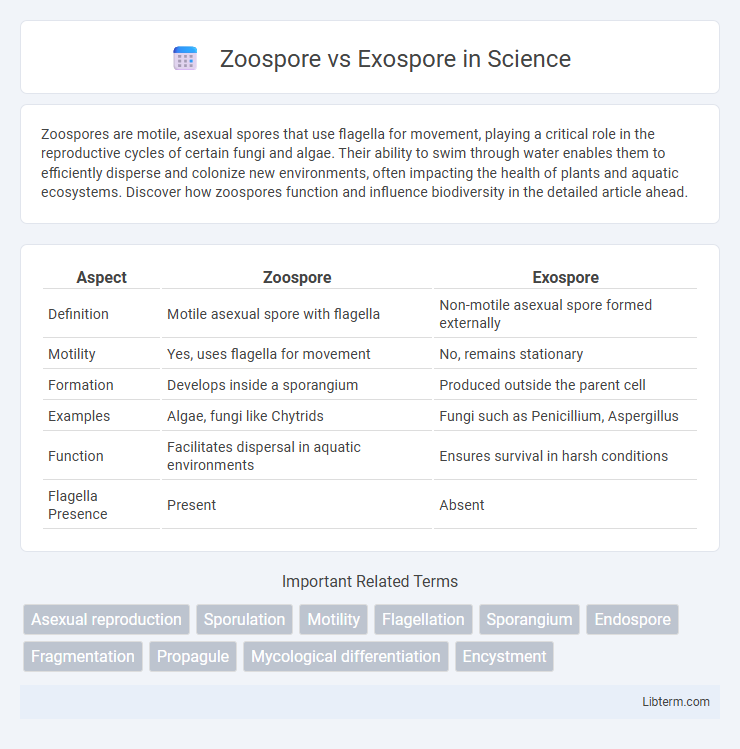Zoospores are motile, asexual spores that use flagella for movement, playing a critical role in the reproductive cycles of certain fungi and algae. Their ability to swim through water enables them to efficiently disperse and colonize new environments, often impacting the health of plants and aquatic ecosystems. Discover how zoospores function and influence biodiversity in the detailed article ahead.
Table of Comparison
| Aspect | Zoospore | Exospore |
|---|---|---|
| Definition | Motile asexual spore with flagella | Non-motile asexual spore formed externally |
| Motility | Yes, uses flagella for movement | No, remains stationary |
| Formation | Develops inside a sporangium | Produced outside the parent cell |
| Examples | Algae, fungi like Chytrids | Fungi such as Penicillium, Aspergillus |
| Function | Facilitates dispersal in aquatic environments | Ensures survival in harsh conditions |
| Flagella Presence | Present | Absent |
Introduction to Zoospores and Exospores
Zoospores are motile asexual spores equipped with flagella, enabling active movement in aquatic environments, primarily found in algae, fungi, and some protozoa. Exospores are non-motile asexual spores formed externally on the parent cell surface, typically observed in certain bacteria and fungi. Both zoospores and exospores play crucial roles in reproduction and dispersal, adapting to different environmental conditions to ensure species survival.
Definition of Zoospore
Zoospores are motile asexual spores equipped with flagella, enabling movement in aquatic environments and facilitating rapid colonization. These spores are produced inside a sporangium and are characteristic of certain algae, fungi, and protists. Unlike exospores, zoospores rely on their flagella for dispersal rather than passive release from the parent organism.
Definition of Exospore
Exospores are a type of asexual spore formed externally on the parent cell, typically characterized by their protective outer covering that aids in survival under harsh conditions. They contrast with zoospores, which are motile spores equipped with flagella, enabling active movement in aquatic environments. Exospores play a crucial role in the propagation and resilience of certain fungi and algae species.
Origin and Formation Mechanisms
Zoospores originate inside a parent cell where they develop flagella for motility, typically formed through mitotic division in certain algae, fungi, and protists. Exospores form externally on the surface of the parent cell through mitotic budding or sporulation without flagella, common in some fungi and bacteria. The key difference lies in zoospores being motile spores enclosed within the parent cell until release, whereas exospores are non-motile spores generated externally for dispersal.
Structural Differences
Zoospores are motile spores equipped with one or more flagella, enabling them to swim in aquatic environments, whereas exospores are non-motile spores formed by budding off the parent cell's exterior. Zoospores possess a cell wall that is typically thin and flexible, facilitating movement, while exospores develop a thicker, more rigid cell wall for protection and dispersal. The presence of flagella in zoospores represents a significant structural adaptation distinguishing them from the flagella-lacking exospores.
Modes of Dispersal
Zoospores disperse through active locomotion using flagella, enabling them to swim in aquatic environments toward favorable conditions. Exospores rely on passive dispersal mechanisms, such as wind or water currents, to reach new locations. These distinct modes of dispersal influence the ecological niches and habitats colonized by organisms producing zoospores versus exospores.
Biological Functions and Roles
Zoospores exhibit motility through flagella, enabling them to actively seek optimal environments for colonization and enhancing dispersal in aquatic and terrestrial habitats. Exospores, being non-motile, rely on passive mechanisms such as water or wind for distribution, serving primarily as resilient survival structures under unfavorable conditions. Zoospores play crucial roles in rapid population expansion and infection processes in pathogens, while exospores contribute significantly to species persistence during environmental stress by facilitating dormancy and resource conservation.
Ecological Significance
Zoospores contribute significantly to aquatic ecosystems by enabling rapid dispersal and colonization in water due to their flagellar motility. Exospores enhance survival in terrestrial and fluctuating environments by forming resistant spores externally, facilitating persistence through harsh conditions. Both types of spores play crucial roles in maintaining microbial biodiversity and ecosystem stability across diverse habitats.
Examples of Organisms Producing Zoospores and Exospores
Chlamydomonas and Phytophthora are prominent examples of organisms producing zoospores, which are motile spores equipped with flagella for movement in aquatic environments. In contrast, Exospores are produced by organisms such as Glomerella and various species of fungi, characterized by non-motile spores formed externally on the parent cell. The distinction between zoospore producers and exospore producers highlights the diverse reproductive strategies across algae, fungi, and protists.
Comparative Summary: Zoospore vs Exospore
Zoospores are motile spores equipped with flagella, enabling them to actively move in aquatic environments, while exospores are non-motile spores produced externally by the parent cell, relying on passive dispersal mechanisms. Zoospores are commonly found in certain algae, fungi, and protists, reproducing asexually under favorable conditions, whereas exospores typically appear in some fungi and algae as a survival strategy under adverse conditions. The primary distinction lies in their mobility and formation process, with zoospores enhancing dispersal through locomotion and exospores ensuring resilience via environmental resistance.
Zoospore Infographic

 libterm.com
libterm.com